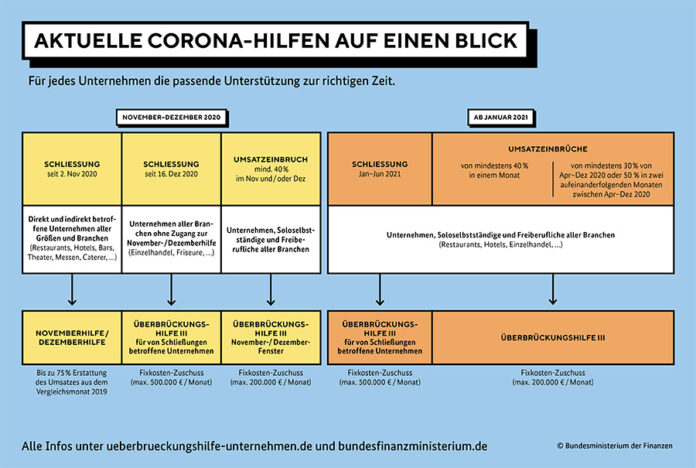As part of its explanation of its new Corona bridge assistance, the federal Department of Finance shows a schedule that includes a lockdown through June 2021.
The office writes: “The bridging aid will be significantly improved once again, and there will also be a non-bureaucratic December aid. This costs a lot of money, but the alternative of a wave of business failures and layoffs would be even more costly for all of us. Together we’ll cope, together we’ll be ready for anything.”
Stephan Kohn, a population protection expert and employee of the German Federal Ministry of the Interior’s Critical Infrastructures Department, pointed out in his extensive, official report, which became known to the public in a leak in May 2020 as the “false alarm paper”, that protective measures in a pandemic represent their own source of danger and that it is an essential task of professional crisis management to keep a close eye on a multi-hazard situation created as a result. Otherwise, there is the threat of official and state liability on a massive scale.
Kohn writes: “Protective measures cannot be used arbitrarily as a preventive measure, because they too carry the potential to cause extraordinary damage.
Thus, in a pandemic, there are always at least two dangers that crisis management must keep in mind: damage to health caused by a pathogen, collateral damage caused by side effects of protective measures, or (as a special case) a false alarm. Because of this dualism, during the course of a pandemic, the probability of exceptional damage occurring and the likely amount of damage that will occur must be continuously tracked simultaneously for all existing hazards. Evaluating data on the incidence of infection and the number of deaths is far from sufficient for this purpose.
A key finding from all studies, exercises and risk analyses to date is that collateral damage always occurs in the fight against a pandemic (as an effect of more protective measures taken), and that this collateral damage of a pandemic can be significantly greater than the damage achievable by the pathogen. Collateral damage, which must always be accepted, has the best cost-benefit ratio if it is no greater than is at least necessary to achieve a protection goal.
It then has the maximum worst cost-benefit ratio if the original warning of an unknown virus turns out in the end to be exaggerated or, in extreme cases, even a false alarm, because then the total damage of the pandemic consists exclusively of the collateral damage, which has no purpose whatsoever.”
Already at the beginning of May 2020, Kohn demands: “The situation reports of the BMI-BMG crisis team and the situation reports of the federal government to the states must therefore, with immediate effect
o carry out an appropriate threat analysis and assessment.
o include an additional section with meaningful data on collateral damage.”
To date, nothing has come to the public’s attention about any such multi-hazard analysis conducted by the government originally or accompanying the measures.
On the contrary, the Bavarian State Chancellery had to admit in a court case led by the lawyer Jessica Hamed in the summer of 2020 that there was nothing in their documents in this respect. The same picture emerged in proceedings in other countries: in a legal dispute led by the entrepreneur Jeroen Pols in the Netherlands, only empty authority files were revealed in this respect in the fall of 2020.
As of November 2020, the leaked situation reports of the Berlin crisis team do not contain any analysis of the collateral damage that now threatens Germany’s existence, especially in economic terms.
The collateral damage is not caused by a viral event that could not be averted in any other way, as Stefan Kohn already pointed out at the beginning of May 2020. The lockdown decisions of the governments, which were taken against all evidence and continued without necessity, rather set an overtaking causality for the damage that has occurred and is deepening more and more.
Kohn writes, “The observable effects and impacts of COVID-19 do not provide sufficient evidence that, in terms of health impacts on society as a whole, it is anything more than a false alarm. At no time did the new virus presumably pose an above-normal risk to the population (the comparator is the usual mortality pattern in Germany). Corona is essentially killing the people who statistically will die this year because they have reached the end of their lives and their weakened bodies can no longer resist any random everyday stresses (including the 150 or so viruses currently in circulation). The danger of Covid-19 was overestimated. (Within a quarter, no more than 250,000 deaths worldwide with Covid-19, compared with 1.5 million deaths during the 2017/18 influenza wave). The threat is obviously no greater than that of many other viruses. In all likelihood, we are dealing with a global false alarm that has gone undetected for a long time.”
In retrospect, it is clear that this was a false alarm as early as March 2020. For reasons that are no longer rationally comprehensible in view of the real virus events, this false alarm still persists in January 2021.




